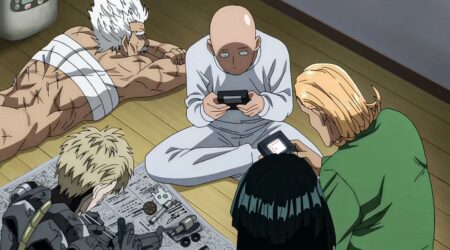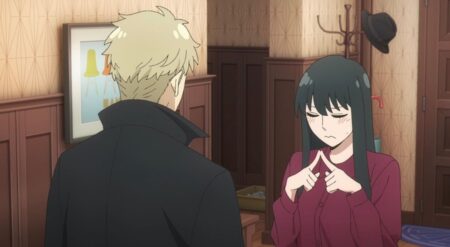
I have been a weeb since we called it otaku and over the years I’ve come to understand and even dabble in a lot of the more specialized communities in the anime fandom. Boy love? Check. Fan service? Yes, I mean, Darling in the Franxx is one of my favorites for a reason. But, I’ve never understood, nor tried to understand the furry community. While furries aren’t exclusive to anime, there is a ven diagram of weebs and furries that is pretty much just a giant circle. Then, Beastars dropped on Netflix and I understand what all the fuss is about now.
Beastars has a lot of the same plot points and tropes that define anime in high school settings. Cliques, awkward leads, and of course, some larger and darker turn of events that pushes the story into a twist that comes out of nowhere and makes you binge-watch the entire 12-episode season in one sitting. The Netflix Original adapts the first 50 chapters of writer and illustrator Paru Itagaki’s manga. Beastars follows Legoshi, a shy and sheepish gray wolf who actively tries to be the weakest one in the room despite towering over carnivore and herbivore alike. A member of the drama club at Cherryton High School, Legoshi does everything he can to avoid conflict and attention, which has led him to be awkward and rather clueless in social situations. But when a dwarf rabbit named Haru sets off his feral instincts, he’s set on a path of maturity that pulls him out of his shell and leads him to find responsibility beyond managing stage lights for a school performance.
As his friendship and love for Haru develops, he has to deal with the emotions that come with having once wanting to eat her which pushes him to discover more about the world of carnivores and the role he’s expected to play within it. He has to make the choice to push back against it and his feral nature or find a way to protect and love the herbivores around him. But this isn’t an easy task. With a kidnapping increasing the adrenaline of the plot, there are some more down to earth elements like a good old love triangle between Legoshi, Haru, and the president of the drama club, the rich, proud, and charismatic Louis who happens to be a red deer.
The season opens with Legoshi’s friend Tem, an alpaca, being eaten by an unknown animal, in what is known as a devouring incident (English dub), which is the gravest crime in this world. This sets the tone for the series, and one of its main themes, instinct and how to manage it or become a slave to it. In the midst of this incident, the suspicion of the wolves at the school and other carnivores ramps up and forces Legoshi’s head even lower, until he meets Haru. From prey to love interest, this romance is used to tell a story beyond the traditional horny anime. But, like Castlevania Season 3, this one definitely is still horny.
What was truly unexpected from Beastars was the amount of depth it would give to its lead female character, Haru. She hits the notes a typical ecchi female character. She’s promiscuous and tries to seduce Legoshi immediately. It would have been easy for her to be one-note and a reason for putting as much mature content as they could into the season, but instead, her promiscuity and identity is explained in detail that showcases that Haru is more than a fan service plot point.
Haru seems innocent, meak, and a victim from the start of the show. And the audience isn’t the only one who sees her as such. Throughout Beastars we see how those around her infantilize her because of her size or her cuteness. But, she’s far bolder than her appearance might suggest, pushed by the fact that she is painfully aware of how close she is to death if a carnivore decides to attack. Haru uses sex as an equalizer, a way to get power in a world that refuses to give it to her. Her promiscuity leads to her being bullied and through it all, she fights back. She has agency and uses it to put others on equal footing with her.

Additionally, Legoshi offers up a compelling protagonist that grows exponentially throughout this first season. So much so, that I immediately read the next 12 chapters of the manga to see where how his story continues after I finished the final episode of the season. As mentioned earlier, the larger message of Beastars is that we can move past the expectations and limitations set on us by both society and circumstance. While Legoshi will always be a wolf and a carnivore, we see him struggle with the instincts and craft his own destiny in spite of the world around him telling him its impossible. What starts from a curiosity about why he’s attracted to Haru, transforms into a very personal need to understanding the hierarchy of his society that shows him experiencing some of its darker sides like the Black Market.
What happens when all the animals in the world are anthropomorphic? Do carnivores just survive on the soy and egg diet given to them in public? Of course not. While many have compared Beastars to Zootopia, for obvious reasons, this mature anime dives headfirst into the moral questions that anthropomorphic animals invite from audiences and sometimes you don’t want to know the answer.
Finally, Beastars is just a beautiful anime. Using 3D animation, I found myself immediately love with the style that myself and other anime fans chide – here’s looking at you Netflix Saint Seya reboot. Every piece of the animation is fluid and escapes a lot of the jumpy moments that a lot of 3D anime experience given how modeling is done and executed. But, this isn’t just a great anime when it comes to visuals because of how the 3D animated characters interact with each other or space, but rather, it’s gorgeous because of how each of the characters represents their anthropomorphized animal. The choices made on how to animate certain features, hide others and show size differences is one that has not only been intriguing in its manga form but when brought to life in the anime are flawlessly executed.
Read Our Review Of Beastars Season 2 Here.
Additionally, it has to be said the characters are extremely attractive and now all the sharing of existing attractive anime characters as furries makes so much more sense. Now, there is a lot about the series that leans into the almost-ecchi high school anime stereotype, but it also holds itself from just being labeled that. While the characters talk a lot about sex, one character is defined by it, and we see it a few times. Beastars never feels gratuitous and instead, you find yourself crushing on Legoshi, and wondering if you’ve been converted to furry fandom because of how wonderful he’s animated.
The only issue I have with this 12-episode series is that one of the episodes, “Below the Fur Coat,” The episode is beyond confusing and just weird. In it, a chicken classmate details how the eggs she lays are used throughout the school. While this adds to the world-building of the show, it lands in the pile of filler that is just weird. That said, there are moments in the episode that are great for Haru but it’s too separate for it to have a large impact.
Overall, Beastars takes the traditional horny high school anime and adds emotional weight and commentary while also loading it full of furry fanservice. It’s filled with world-building that shows that each aspect of the world, the good, the funny, and the bad, have all be thought through. Additionally, these characters not only made me understand furries, but also gave me a really compelling story.
Beastars is streaming exclusively on Netflix.
Beastars
-
Rating - 8.5/108.5/10
TL;DR
Beastars takes the traditional horny high school anime and adds emotional weight and commentary while also loading it full of furry fanservice.







